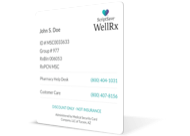Copyright 2024
Medical Security Card Company, LLC
All Rights Reserved
WellRx will never sell your personal information. Period. By signing up I agree to WellRx's terms of use and privacy policy.
By Teresa Otto, MD
November 18, 2022
Several patients told urologist Dr. David Wartinger that they’d passed their kidney stones after riding on the Big Thunder Mountain ride at Walt Disney World. So, Wartinger and Dr. Marc Mitchell tested the theory using model kidneys with stones on Disney roller coasters. "The ideal coaster is rough and quick with some twists and turns,” Wartinger said, “but no upside down or inverted movements.”
Read on for their roller coaster recommendations and 13 more things to know about kidney stones — including how to save enough money on your prescription drugs to buy your Disney World day pass.
Men get kidney stones more often than women do. About 11% of men and 9% of women in the United States have had at least one kidney stone. The gap between males and females used to be wider, though. Along with the rising number of women, the number of adolescent girls with kidney stones has been climbing.
Adolescent girls aren’t the only ones affected. In the last 30 years, kidney stones in children have doubled. Although all the reasons for this aren’t known, researchers suspect the rising rates of obesity in children and the trend toward eating processed food contributed to the increase.
The prevalence of kidney stones varies across the United States, with those living in the Southeast having more kidney stones than elsewhere in the country. Salty foods increase the chance of kidney stones. So does dehydration that accompanies hot weather. Climbing temperatures have pushed the kidney stone high-risk zone farther north.
Kidney stones need crystal-forming substances, such as calcium, oxalate, and uric acid, to form. Once a tiny crystal develops, more of the same substances attach. The resulting kidney stone may be the size of a grain of sand or as big as a golf ball.
The majority of kidney stones are formed from calcium and oxalate (made in your liver and found in spinach, soy, almonds, and potatoes). Other types of stones include:
Along with crystal-forming substances, concentrated urine predisposes you to kidney stones. Medical conditions that lead either to dehydration or an abundance of minerals in the urine include:
You are also more likely to get kidney stones if:
Only those of you who’ve delivered both babies and kidney stones can weigh in on this. As an anesthesiologist, I’ve seen patients in labor and patients passing kidney stones from the kidney to the bladder by way of a small tube called the ureter. Delivering both causes a lot of pain.
A kidney stone passing through the ureter causes symptoms such as:
Nearly half of all kidney stones may be asymptomatic. Each year two million people are diagnosed with asymptomatic kidney stones found on x-rays, CT scans, or MRIs taken for another medical problem.
Debate continues about removing asymptomatic stones. About 20% of them will eventually cause problems. If you have small asymptomatic stones and are otherwise healthy enough to ride a roller coaster, Wartinger and Mitchell say it is worth a try.
If you have any symptoms of a kidney stone, you’ll need to seek medical care. Along with your medical history and a physical exam, your healthcare provider will get a urine sample, a blood sample to look at your kidney function, and imaging studies to look for:
Stones less than 5 millimeters in diameter, about the size of a pencil eraser, usually pass on their own. Your healthcare provider will recommend pain and nausea medications, such as:
Stones from 5 to 10 millimeters in diameter (the size of a pea) may pass on their own, especially if they have already traveled some distance from the kidney toward the bladder. Your healthcare provider may prescribe medications (see below) to help push the stone through the ureter or recommend removal by a urologist, a physician specializing in the urinary system.
Stones 10 millimeters or larger may stay in the kidney. If they do enter the ureter, they’re unlikely to pass on their own and will require lithotripsy, a non-invasive treatment that pulverizes kidney stones with shock waves, or surgery.
Surgical procedures can also be minimally invasive, not requiring an incision. A urologist may remove a whole stone in your ureter or bladder or break it into tiny pieces with a laser.
Percutaneous nephrolithotomy, a procedure in which an incision is made into the kidney, removes trapped stones that are:
In addition to medications that help with the pain and nausea associated with passing a kidney stone, several prescription drugs relax the ureter. These medications increase the likelihood of the stone passing without a surgeon helping it along. Medications include:
By comparing prescription prices on ScriptSave® WellRx, it doesn’t take long to save enough money to buy yourself and a fellow stone maker, a pair of $109, passes for Walt Disney World. A search by zip code for the lowest prescription price in a pharmacy near you can save on medications for treating and preventing kidney stones and on other over-the-counter and prescription medicines you take.
A WellRx price check shows a $75 savings for ondansetron, a $10 savings for ibuprofen, an $11 savings for ketorolac, a $45 savings on nifedipine, and a $92 savings on captopril* — enough for two passes.
To discover how prescription discount cards work, to receive coupons for medications, and to enroll for your free Rx savings card, visit WellRx.
One of the best ways to prevent recurrent kidney stones is to stay well hydrated and keep your urine dilute. Dilute urine means the crystal-forming minerals and salts are less concentrated, less likely to congregate, and less likely to form stones.
Some drinks are better than others. Here’s what should be on your sip list:
Drinking sugar-sweetened soda increases your risk of kidney stones.
Here are some general guidelines:
These recommendations look a lot like the Dietary Approaches to Stop Hypertension (DASH) eating plan. On the DASH eating plan, you eat fruits, vegetables, lean meats, low-fat dairy, and whole grains while reducing sugar, fatty meats, full-fat dairy, and salt. Adopting this diet appears to reduce your chances of developing kidney stones.
If you form calcium-oxalate kidney stones, your healthcare provider may recommend limiting high-oxalate foods, such as:
Depending on the type of kidney stones your body makes, medications may help prevent their formation.
Calcium stones are the most common. Thiazide diuretics (water pills) reduce the calcium in your urine and can help prevent more stones from forming. Thiazide diuretics include:
If you have chronic urinary tract infections, you may form struvite stones. Long-term antibiotics, such as nitrofurantoin or trimethoprim-sulfamethoxazole (Bactrim), may help reduce the bacteria present in your urine and lower your chance of forming more struvite stones.
For those of you who form uric acid stones, allopurinol (Zyloprim) helps reduce the amount of uric acid in your blood and urine.
And finally, if you make cystine stones because you have the inherited disease, cystinuria, captopril (Capoten) helps lower the level of cystine in your urine.
Of all the preventative measures and medications we’ve covered, drinking water is the most important. But there’s one more option for those healthy enough to ride a roller coaster.
Drs. Wartinger and Mitchell rode Big Thunder Mountain, Space Mountain, and Aerosmith’s Rock’n Roller with a silicone kidney model containing kidney stones of different sizes and shapes. Here’s what they found:
Consult with your doctor about the best way to manage your kidney stones.
*DISCOUNT ONLY – NOT INSURANCE. The program is administered by Medical Security Card Company, LLC
Teresa Otto, MD, is a freelance medical writer on a mission to inform readers about the positive impact of good nutrition and a healthy lifestyle. She is a retired anesthesiologist who practiced in Billings, Montana, for most of her career. She graduated from the University of Washington School of Medicine in Seattle and did her anesthesia residency and fellowship at New York University and Columbia-Presbyterian in New York.

For your convenience, use the ScriptSave® WellRx mobile app. Now savings are well in hand, right at the pharmacy counter. Save on your family's prescription medicines.
Learn More
Your choice. Get a ScriptSave WellRx Savings Card. Or Download the free mobile app from the App Store or Google Play Store
Get A Card
ScriptSave WellRx Grocery Guidance leverages leading-edge nutritional data science to help you know which food products on your grocery store shelf are truly good for YOU.
Healthy Foods For YouTags:

November 07, 2024

October 23, 2024

May 07, 2024
You need to log into the site to use this feature
This feature requires registration. Sign up or log in to your free WellRx account to gain access to this and other tools to help make managing your medications and wellness easier.
Benefits Include:
 Store & manage your medication list
Store & manage your medication list
 Medication pricing updates
Medication pricing updates
 Medication information
Medication information
 Pill & refill reminders
Pill & refill reminders
 Medication journal & mood log
Medication journal & mood log
This feature requires registration. Sign up or log in to your free WellRx account to gain access to this and other tools to help make managing your medications and wellness easier.
Benefits Include:
 Store & manage your medication list
Store & manage your medication list
 Medication pricing updates
Medication pricing updates
 Medication information
Medication information
 Pill & refill reminders
Pill & refill reminders
 Medication journal & mood log
Medication journal & mood log
You will be redirected to your program in 5 seconds.
Our Terms and Conditions and Privacy Policy have recently been updated.
By declining you will be logged out of your account